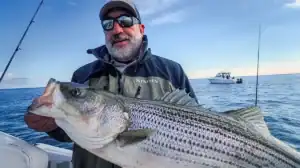Spencer Brodgen, age 45, was doing yardwork along the edge of a residential pond in suburban Jacksonville Beach, Fl. It was midday on Apr. 15, when he happened to glance down into clear, two-feet deep water along a shoreline.
“I couldn’t believe what I was seeing,” said Brogden, a veteran saltwater angler who owns Spencer’s Creations landscaping business. “There were a pair of 2-pound dark colored adult catfish near a fanned-nesting spot, and a ‘tornado’ of thousands of tiny little black catfish fry spinning round-and-round above the nest.
“It was incredible. I’ve fished all my life, and I’ve been near that pond many times. But I’ve never seen anything like that.”
Brogden says the fry looked like small tadpoles but definitely were mini catfish. The pond is jammed with sunfish and bass, and plenty of winged predators are nearby — like egrets, herons, ospreys and raccoons. But nothing was harassing the bigger cats or their young.
“The pond is pure freshwater, and I’ve seen bass, bream and carp there – but never catfish,” he said. “I watched them for 90 minutes swirling tornado-like and videoed them. Fishing buddies of mine wouldn’t believe what I saw without a video. I didn’t see any other catfish or fry that day along the bank.”
A Swarm of Bullheads
Wired2Fish contacted Bob DeMauro, a fisheries biologist and biological administrator for the Florida Fish and Wildlife Conservation Commission [FWC], asking for his input on Brogden’s remarkable catfish video.
“That’s a really interesting video,” said the manager at FWC’s panhandle region Blackwater Hatchery in Santa Rosa County. “I think these are bullheads and not channel catfish. Channel catfish have forked tails while bullheads typically have rounded tails like those in the video. I can’t positively identify them in the video, but I would lean towards them being bullheads.”
The biologist with 35 years of FWC experience said catfish and bullheads have much the same spawning characteristics. DeMauro says that when fry first hatch, their mouths and fins are not fully formed and they get their nutrition from yolk sacs that form as the fry mature in the egg. During this stage the male is the primary caregiver and protector, which in the video is the fish closest to the fry school. However, the female generally stays in the vicinity and provides some assistance in the protection and caregiving of the young.
“You can see her in the video not far away from the school of fry,” DeMauro says. This caregiving and protection activity continues until the mouth and fins of the fry fully form and the yolk sac is used up.”
He says when fry yolk sacks are gone, catfish/bullhead young can find prey items on their own and they begin to disperse from the group. Depending on water temperature, this generally takes about one to two weeks from the time they hatch until they disperse, and adults no longer provide protection and caregiving of the larval school.
“Catfish and bullheads prefer to spawn in hollow logs and cover areas near shoreline banks,” DeMauro explained. “But they will just fan nests and lay many thousands of eggs that become fry if logs or other cover is unavailable.
“Catfish fry mortality is huge. All kinds of predators eat them, and bass are especially deadly. A very small percentage of catfish fry make it to adult size – usually less than 10 percent.”












